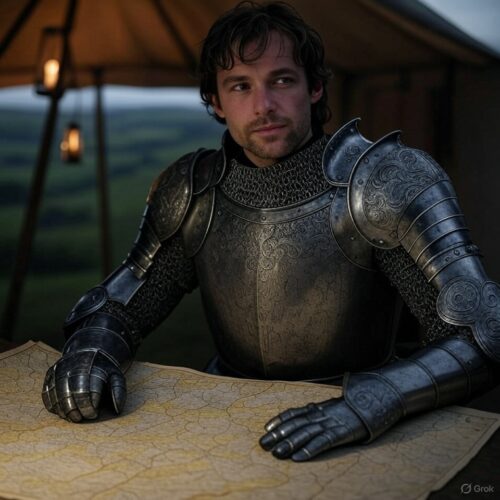Welcome to a journey back in time, where the clash of swords under a raging thunderstorm not only decided the fate of a kingdom but also sowed the seeds for democratic ideals that echo in our halls of power today. On August 4, 1265, the Battle of Evesham unfolded in the rolling hills of Worcestershire, England—a pivotal moment in the Second Barons’ War that pitted visionary reformers against royal loyalists. This wasn’t just a skirmish; it was a dramatic showdown that ended one era and birthed another, with lessons in strategy, loyalty, and perseverance that can supercharge your life in the 21st century. Buckle up as we dive deep into the history, with a treasure trove of details to educate and entertain, before unveiling how you can harness this ancient saga for modern motivation.
### The Turbulent Backdrop: England’s Barons Rise Against the Crown
To understand the Battle of Evesham, we must rewind to the mid-13th century, a time when England was a cauldron of political unrest under King Henry III. Henry, son of the infamous King John who had signed the Magna Carta in 1215, inherited a throne fraught with challenges. His reign, beginning in 1216 when he was just nine years old, was marked by extravagant spending, favoritism toward foreign relatives, and disastrous military campaigns. Henry showered lands and titles on his French half-brothers from his mother’s second marriage, alienating the native English nobility. His attempts to reclaim lost territories in France drained the treasury, forcing him to levy heavy taxes and sell privileges to the highest bidder.
By the 1250s, the barons—powerful landowners who formed the backbone of England’s feudal system—had had enough. Led by Simon de Montfort, the 6th Earl of Leicester, they demanded reforms. De Montfort was no ordinary noble; born in France around 1208, he was the son of a Crusader who had led the brutal Albigensian Crusade. Simon arrived in England in 1229, claiming his inheritance, and quickly rose in favor, even marrying Henry’s sister Eleanor in 1238. But his relationship with the king soured over financial disputes and Henry’s autocratic style.
The turning point came in 1258 with the Provisions of Oxford. This set of reforms, forced upon Henry by the barons, established a council of 15 to advise the king, limited his powers, and aimed to curb corruption. It was revolutionary—essentially an early constitution that required parliamentary approval for major decisions. Henry, however, reneged on the Provisions in 1261 with papal support, sparking open rebellion. The Second Barons’ War erupted, a civil conflict that divided families and tested allegiances.
De Montfort emerged as the barons’ champion. Charismatic and militarily adept, he envisioned a government where the king was accountable to his subjects, including not just barons but knights and burgesses. In January 1265, he summoned what is often called the first English Parliament, inviting representatives from towns and shires—a radical step toward representative democracy. But success was fleeting. At the Battle of Lewes on May 14, 1264, de Montfort’s forces captured Henry, Prince Edward (the future Edward I), and Richard of Cornwall, giving him de facto control of England.
Yet, cracks appeared. Key allies like Gilbert de Clare, Earl of Gloucester, defected, suspicious of de Montfort’s growing power and his alliance with Llywelyn ap Gruffudd, the Prince of Wales. This pact, signed in June 1265, granted Llywelyn recognition as Prince of Wales in exchange for military aid, but it cost de Montfort popularity among English lords who saw it as selling out national interests. Prince Edward escaped custody on May 28, 1265, thanks to a clever ruse involving horse racing to tire guards, and joined forces with Gloucester and other royalists like Roger Mortimer and John de Warenne.
The stage was set for confrontation. De Montfort, holding the king as a figurehead, marched his army from Hereford toward Worcester, aiming to link up with his son, Simon the Younger, who was rallying forces in the southeast. But the younger Simon dawdled, sacking Winchester and resting at Kenilworth Castle. Edward, ever the strategist, struck first. On August 1, he surprised and defeated the younger Simon’s forces at Kenilworth, capturing banners and standards that would prove crucial.
De Montfort, unaware of this, crossed the River Severn and reached Evesham Abbey on August 3, where he dined with the abbot and rested his weary troops. Scouts reported royalist movements, but de Montfort dismissed them, confident in his position. Little did he know, Edward had marched 35 miles overnight with 10,000 men, positioning himself to trap the barons in a bend of the River Avon.

### Key Players: Heroes, Villains, and the Human Drama
The Battle of Evesham was as much about personalities as politics. Simon de Montfort, aged about 57, was a seasoned warrior with Crusading experience in the Holy Land. He was pious, often wearing a hair shirt under his armor, and driven by a mix of ambition and genuine reformist zeal. His sons—Henry, Simon the Younger, and Guy—fought alongside him, adding a familial stake to the conflict.
On the royalist side, Prince Edward, 26 years old, was a towering figure at 6 feet 2 inches, nicknamed “Longshanks.” He had learned from his defeat at Lewes, adopting innovative tactics like the use of reserves and deception. Gilbert de Clare, the “Red Earl,” was a volatile ally, switching sides for personal gain. Roger Mortimer, a Marcher lord, brought fierce border fighters, while William de Valence, Henry’s half-brother, sought revenge for humiliations at Lewes.
Interesting anecdote: De Montfort had once been Edward’s godfather and close advisor, teaching him military skills. As the battle loomed, de Montfort reportedly remarked on Edward’s advance: “They have not learned that for themselves, but were taught it by me.” It was a bittersweet acknowledgment of his former protégé’s growth.
King Henry III, 57 and in de Montfort’s custody, was a reluctant participant. Dressed in baronial colors to blend in, he nearly got killed by his own side until he shouted, “I am Henry of Winchester, your king! Do not kill me!”
The Welsh infantry under Llywelyn provided support but were unreliable, fleeing early in the fight—a reminder of the fragile alliances in medieval warfare.

### The Fateful Day: Thunder, Treachery, and Carnage
August 4, 1265, dawned with ominous weather. A massive thunderstorm brewed, darkening the skies and turning the ground muddy—conditions that would hamper movement and add to the chaos. De Montfort’s force of about 5,000, including 300 knights and Welsh foot soldiers, was encamped near Evesham. Edward’s 10,000 men approached from the north, using the captured Kenilworth banners to masquerade as reinforcements from Simon the Younger.
De Montfort’s watchman climbed the abbey tower and spotted the deception too late. “We are all dead men,” he reportedly said. De Montfort, realizing the trap—the Avon at his back, no bridge escape—rallied his men. “Let us commend our souls to God, because our bodies are theirs,” he said, showing his steely resolve.
The barons formed a tight formation on the hill, with de Montfort in the center, his sons on the flanks. Edward divided his army into three divisions: himself on the left, Gloucester on the right, and Mortimer in reserve to block retreat. The royalists wore red crosses for identification, a tactic borrowed from de Montfort’s white crosses at Lewes.
As lightning flashed and rain poured, the charge began around 9 a.m. The Welsh deserted almost immediately, swimming the Avon or being cut down. De Montfort’s knights fought fiercely, breaking through the center momentarily, but the royalists enveloped them in a pincer movement. It was less a battle than a slaughter; royalists, bitter from Lewes where they were humiliated, showed no mercy. Knights were dragged from horses and beheaded; foot soldiers massacred.
De Montfort’s horse was killed under him, and he fought on foot with sword and shield. “Thank God,” he said as he fell, pierced by lances. His body was horrifically mutilated—head, hands, feet, and genitals severed, the head sent to Lady Mortimer as a trophy. Henry de Montfort died shielding his father. Guy and others were captured.
The king, wandering the field, was rescued by Roger de Leybourne, who knelt and said, “My lord king, what do you here?” Henry replied tearfully, safe at last.
The battle lasted about three hours, with baronial losses nearing 4,000, royalist casualties minimal. The storm cleared as the fighting ended, as if nature itself mourned the fallen.
Anecdote: One knight, Adam de Mohaut, hid in the abbey but was discovered and killed. The abbey church was desecrated with blood, bodies piled high.

### Aftermath and Lasting Legacy: From Massacre to Modern Governance
The immediate aftermath was grim. De Montfort’s remains were buried secretly at Evesham Abbey, but miracles were reported at his grave, turning him into a folk hero and near-saint. The royalists plundered Evesham, but Edward showed restraint, pardoning some prisoners.
Resistance lingered. Simon the Younger held Kenilworth Castle until December 1266, enduring the longest siege in English history. The Dictum of Kenilworth in October 1266 allowed rebels to redeem lands, promoting reconciliation. By 1267, the war ended, with Henry regaining control but adopting some reforms.
Evesham’s significance is profound. De Montfort’s defeat restored monarchy, but his parliamentary experiment inspired future developments, like the Model Parliament of 1295 under Edward I. Historians credit him as a founder of constitutional government. Edward, hardened by the war, became a formidable king, conquering Wales and reforming laws.
Fun fact: The battle site features a monument erected in 1965 for the 700th anniversary, and reenactments bring the drama to life annually. Artifacts like arrowheads still turn up in fields.
The war cost England dearly—famines, plagues followed—but it forged a more unified realm. Chroniclers like Robert of Gloucester called it “the murder of Evesham,” emphasizing its brutality.

### Bridging Centuries: How Evesham’s Lessons Empower You Today
While the Battle of Evesham was a tragedy for reformers, its outcome—restored stability blended with innovative ideas—offers timeless wisdom. De Montfort’s vision survived his death, influencing democratic systems we enjoy. Edward’s strategic brilliance shows how adversity breeds excellence. Applying this to your life can build resilience, sharpen decision-making, and foster leadership.
Here’s how you benefit today:
– **Strategic Foresight in Daily Decisions**: Like Edward’s overnight march, anticipate challenges. Benefit: Avoid surprises in career or relationships, leading to better outcomes.
– **Building Reliable Alliances**: De Montfort’s Welsh betrayal highlights trust’s importance. Benefit: Cultivate strong networks, reducing isolation and boosting opportunities.
– **Perseverance Amid Setbacks**: De Montfort fought to the end. Benefit: Overcome personal failures, like job loss, with renewed vigor.
– **Learning from Mentors and Rivals**: Edward learned from de Montfort. Benefit: Turn competitors into teachers, accelerating growth.
– **Balancing Ambition with Ethics**: The Provisions’ legacy promotes accountability. Benefit: Achieve goals without compromising values, enhancing fulfillment.
A Practical Plan to Apply Evesham’s Wisdom:
- **Week 1: Reflect on History**: Read about de Montfort or watch a documentary. Journal how his reforms mirror modern rights.
- **Week 2: Assess Alliances**: List your key relationships. Strengthen three with meaningful gestures; distance from unreliable ones.
- **Week 3: Develop Strategy**: Set a goal (e.g., promotion). Map obstacles like Edward, create contingency plans.
- **Week 4: Practice Resilience**: Face a small challenge deliberately (e.g., cold shower daily). Track mood improvements.
- **Ongoing: Lead with Vision**: Volunteer for a community role, applying accountability like the Provisions. Review progress monthly.
Embrace Evesham’s spirit—turn history’s storms into your personal triumphs. The past isn’t dead; it’s your playbook for an epic life! 

